Spatial Zoning of the Value Realization Models for Ecological Products in Shibing Karst Natural World Heritage Site
Abstract
1. Introduction
2. Materials and Methods
2.1. Study Area
2.2. Equivalent Factor Method
2.2.1. Standard Equivalent Calculation
2.2.2. Revised Ecological Product Value Equivalent Coefficient
2.2.3. Calculation of EPV
2.3. Spatial Zoning Method of the Main EPV Realization Models
2.4. Data Sources
3. Results
3.1. Spatiotemporal Changes in Land Use
3.1.1. Temporal Changes in Land Use
3.1.2. Transformation among Land Use Types
3.2. The Spatiotemporal Pattern of EPV
3.2.1. Changes in EPV of Different Land Use Types
3.2.2. Economic Value of Different Ecological Products
3.2.3. Spatial Distribution of EPV
3.3. Models and Paths of EPV Realization
3.3.1. The Construction of Indicator System for EPV Realization
3.3.2. Spatial Zoning of the Value Realization Models
4. Discussion
4.1. Factors Affecting Land Use Changes
4.2. The Spatiotemporal Changes of EPV
4.3. EPV Realization Models
4.4. Implications for Other Protected Areas
5. Conclusions
Author Contributions
Funding
Data Availability Statement
Acknowledgments
Conflicts of Interest
References
- Daily, G.C.; Soderqvist, T.; Aniyar, S.; Arrow, K.; Dasgupta, P.; Ehrlich, P.R.; Folke, C.; Jansson, A.; Jansson, B.O.; Kautsky, N.; et al. The value of nature and the nature of value. Science 2000, 289, 395–396. [Google Scholar] [CrossRef] [PubMed]
- Xie, G.D. Mechanism for realizing the value of ecosystem services. Environ. Prot. 2012, 17, 16–18. [Google Scholar] [CrossRef]
- Ministry of Ecology and Environment of the People’s Republic of China Has Issued the “Technical Guidelines for Calculating Gross Ecosystem Product of Terrestrial Ecosystems”. Available online: http://www.caep.org.cn/zclm/sthjyjjhszx/zxdt_21932/202010/t20201029_805419.shtml (accessed on 29 October 2020).
- Ouyang, Z.Y.; Song, C.S.; Zheng, H.; Polasky, S.; Xiao, Y.; Bateman, I.J.; Liu, J.G.; Ruckelshaus, M.; Shi, F.Q.; Xiao, Y.; et al. Using gross ecosystem product (GEP) to value nature in decision making. Proc. Natl. Acad. Sci. USA 2020, 117, 14593–14601. [Google Scholar] [CrossRef] [PubMed]
- Zhang, L.B.; Yu, H.Y.; Hao, C.Z.; Wang, H.; Luo, R.J. Redefinition and connotation analysis of ecosystem product. Res. Environ. Sci. 2021, 34, 655–660. [Google Scholar] [CrossRef]
- Ouyang, Z.Y.; Lin, Y.Q.; Song, C.S. Research on gross ecosystem product(GEP): Case study of Lishui City, Zhejiang Province. Environ. Sustain. Dev. 2020, 45, 80–85. [Google Scholar] [CrossRef]
- Lin, A.; Shen, Y.Q.; Xiao, Y.; Ouyang, Z.Y. Research on accounting of ecological products value in national parks. Acta Ecol. Sin. 2023, 43, 208–218. [Google Scholar]
- Lin, Y.Q.; Xu, W.H.; Li, P.; Wang, X.K.; Ouyang, Z.Y. Assessing the realization of values of ecosystem products: A case study of Li shui, China. Acta Ecol. Sin. 2023, 43, 189–197. [Google Scholar]
- Daily, G.C.; Ruckelshaus, M. 25 years of valuing ecosystems in decisions. Nature 2022, 606, 465–466. [Google Scholar] [CrossRef]
- System of Environmental-Economic Accounting—Ecosystem Accounting (SEEA EA). Available online: https://seea.un.org/ecosystem-accounting (accessed on 29 September 2021).
- Ouyang, Z.Y.; Zhu, C.Q.; Yang, G.B.; Xu, W.H.; Zheng, H.; Zhang, Y.; Xiao, Y. Gross ecosystem product: Concept, accounting framework and case study. Acta Ecol. Sin. 2013, 33, 6747–6761. [Google Scholar] [CrossRef]
- Robertson, G.P.; Swinton, S.M. Reconciling agricultural productivity and environmental integrity: A grand challenge for agriculture. Front. Ecol. Environ. 2005, 3, 38–46. [Google Scholar] [CrossRef]
- Kareiva, P.; Marvier, M. Conserving biodiversity coldspots—Recent calls to direct conservation funding to the world’s biodiversity hotspots may be bad investment advise. Am. Sci. 2003, 91, 344–351. [Google Scholar] [CrossRef]
- Zhang, B.A.; Li, W.H.; Xie, G.D. Ecosystem services research in China: Progress and perspective. Ecol. Econ. 2010, 69, 1389–1395. [Google Scholar] [CrossRef]
- Yu, Z.Y.; Bi, H. The key problems and future direction of ecosystem services research. In Proceedings of the International Conference on Energy, Environment and Development (ICEED), Kuala Lumpur, Malaysia, 8–9 December 2010; Elsevier Science Bv.: Amsterdam, The Netherlands, 2010. [Google Scholar]
- Costanza, R.; dArge, R.; deGroot, R.; Farber, S.; Grasso, M.; Hannon, B.; Limburg, K.; Naeem, S.; Oneill, R.V.; Paruelo, J.; et al. The value of the world’s ecosystem services and natural capital. Nature 1997, 387, 253–260. [Google Scholar] [CrossRef]
- Xie, G.D.; Zhen, L.; Lu, C.X.; Xiao, Y.; Chen, C. Expert knowledge based valuation method of ecosystem services in China. J. Nat. Resour. 2008, 23, 911–919. [Google Scholar]
- Wang, W.J.; Guo, H.C.; Chuai, X.W.; Dai, C.; Lai, L.; Zhang, M. The impact of land use change on the temporospatial variations of ecosystems services value in China and an optimized land use solution. Environ. Sci. Policy 2014, 44, 62–72. [Google Scholar] [CrossRef]
- Costanza, R.; de Groot, R.; Sutton, P.; van der Ploeg, S.; Anderson, S.J.; Kubiszewski, I.; Farber, S.; Turner, R.K. Changes in the global value of ecosystem services. Glob. Environ. Chang. 2014, 26, 152–158. [Google Scholar] [CrossRef]
- Li, L.; Qian, Y.C.; Yan, W.D. Research on the evaluation index system for ecological civilizaion construction in major function zoning. J. Cent. South Univ. For. Technol. Soc. Sci. 2021, 15, 1–8. [Google Scholar] [CrossRef]
- Transforming Our World: The 2030 Agenda for Sustainable Development. Available online: https://sdgs.un.org/2030agenda (accessed on 21 October 2015).
- Xiao, J.; Xiong, K.N. A review of agroforestry ecosystem services and its enlightenment on the ecosystem improvement of rocky desertification control. Sci. Total Environ. 2022, 852, 17. [Google Scholar] [CrossRef]
- Xu, G.Y.; Xiao, J.; Oliver, D.M.; Yang, Z.Q.; Xiong, K.N.; Zhao, Z.M.; Zheng, L.L.; Fan, H.X.; Zhang, F.X. Spatio-temporal characteristics and determinants of anthropogenic nitrogen and phosphorus inputs in an ecologically fragile karst basin: Environmental responses and management strategies. Ecol. Indic. 2021, 133, 16. [Google Scholar] [CrossRef]
- Pei, J.; Wang, L.; Huang, H.B.; Wang, L.; Li, W.; Wang, X.Y.; Yang, H.; Cao, J.H.; Fang, H.J.; Niu, Z. Characterization and attribution of vegetation dynamics in the ecologically fragile South China Karst: Evidence from three decadal Landsat observations. Front. Plant Sci. 2022, 13, 15. [Google Scholar] [CrossRef]
- Pang, D.B.; Cao, J.H.; Dan, X.Q.; Guan, Y.H.; Peng, X.W.; Cui, M.; Wu, X.Q.; Zhou, J.X. Recovery approach affects soil quality in fragile karst ecosystems of southwest China: Implications for vegetation restoration. Ecol. Eng. 2018, 123, 151–160. [Google Scholar] [CrossRef]
- Zhang, S.H.; Xiong, K.N.; Deng, X.H.; Kong, L.W.; Min, X.Y. Impact of ecological restoration on ecosystem service trade-offs: Insight from karst desertification control. Land Degrad. Dev. 2023, 34, 2693–2706. [Google Scholar] [CrossRef]
- Jiang, Y.; Gao, J.B.; Wu, S.H.; Jiao, K.W. Mediation effect as the component to ecosystem? Establishing the chain effect framework of ecosystem services across typical karst basin in China. Catena 2023, 221, 10. [Google Scholar] [CrossRef]
- Xiong, K.N.; Li, J.; Long, M.Z. Features of soil and water loss and key issues in demonstration areas for combating karst rocky desertification. Acta Geogr. Sin. 2012, 67, 878–888. [Google Scholar]
- Zhang, Z.Z.; Xiong, K.N.; Chang, H.H.; Zhang, W.X.; Huang, D.H. A review of eco-product value realization and ecological civilization and its enlightenment to karst protected areas. Int. J. Environ. Res. Public Health 2022, 19, 5892. [Google Scholar] [CrossRef]
- Guo, X.J.; Jiang, G.H.; Gong, X.P.; Yin, J.J.; Wu, X. Recharge processes on typical karst slopes implied by isotopic and hydrochemical indexes in Xiaoyan Cave, Guilin, China. J. Hydrol. 2015, 530, 612–622. [Google Scholar] [CrossRef]
- Zhang, L.M.; Wu, Y.N.; Yan, L.B.; Wang, Y.; Chen, J.; Yu, L.F. Modeling the maximal organic carbon saturation capacity in karst forest soils of China: Comparing the existing models. Appl. Ecol. Environ. Res. 2021, 19, 4115–4128. [Google Scholar] [CrossRef]
- Fang, Q.; Zhao, L.S.; Hou, R.; Fan, C.H.; Zhang, J.X. Rainwater transformation to runoff and soil loss at the surface and belowground on soil-mantled karst slopes under rainfall simulation experiments. Catena 2022, 215, 9. [Google Scholar] [CrossRef]
- Fan, C.H.; Zhao, L.S.; Hou, R.; Fang, Q.; Zhang, J.X. Quantitative analysis of rainwater redistribution and soil loss at the surface and belowground on karst slopes at the microplot scale. Catena 2023, 227, 10. [Google Scholar] [CrossRef]
- Yan, Y.J.; Dai, Q.H.; Yang, Y.Q.; Lan, X. Effects of vegetation restoration types on soil erosion reduction of a shallow karst fissure soil system in the degraded karst areas of Southwestern China. Land Degrad. Dev. 2023, 34, 2241–2255. [Google Scholar] [CrossRef]
- Guo, Y.; Du, X.Y.; Li, D.D.; Zheng, G.D.; Zhang, X.Y.; Chen, H.K.; Zheng, J. How newly developed shale gas facilities influence soil erosion in a karst region in SW China. Sci. Total Environ. 2022, 818, 8. [Google Scholar] [CrossRef]
- Yang, Y.; Xiong, K.N.; Huang, H.Q.; Xiao, J.; Yang, B.L.; Zhang, Y. A commented review of eco-product value realization and ecological industry and its enlightenment for agroforestry ecosystem services in the karst ecological restoration. Forests 2023, 14, 448. [Google Scholar] [CrossRef]
- Sun, B.W.; Peng, X.S. Ecological product value realization models, key issues, and institutional guarantee system. Ecol. Econ. 2021, 37, 13–19. [Google Scholar]
- Qiu, S.L.; Jin, L.S. Realizing the value of ecological products: Theoretical basis, basic logic, and main models. Agric. Econ. 2021, 408, 106–108. [Google Scholar]
- Fang, M. Zhejiang model and experience of realizing ecological product value. Environ. Prot. 2020, 48, 25–27. [Google Scholar] [CrossRef]
- Zhang, L.B.; Yu, H.Y.; Hao, C.Z.; Wang, H. Practice model and path of ecosystem product value realization. Res. Environ. Sci. 2021, 34, 1407–1416. [Google Scholar] [CrossRef]
- Ye, Y.H.; Xiao, B.; Feng, H.J.; He, Y.L.; Chen, P.; Chen, X.Y.; Wang, D.D.; Zeng, Z.X.; Guo, X. Researches on the pattern and route of ecological product value realization from the perspective of rural revitalization. Ecol. Environ. Sci. 2022, 31, 421–428. [Google Scholar] [CrossRef]
- Xie, H.L.; Chen, Q.R. The connotation, goal and mode of realizing the value of ecological products. Econ. Geogr. 2022, 42, 147–154. [Google Scholar] [CrossRef]
- Wang, H.; Li, Q.; Wen, Y.L. The logic and modes of the realization mechanism of ecological product values: A theoretical analysis based on the excludability. China Land Sci. 2022, 36, 79–85. [Google Scholar]
- Wang, G.H. Suitability evaluation of ecological product development in Pizhou. J. Zhejiang Agric. Sci. 2023, 64, 992–1003. [Google Scholar] [CrossRef]
- Wu, S.H.; Hou, X.R.; Peng, M.X.; Cheng, M.; Xue, J.B.; Bao, H.J. Suitability assessment and zoning of value realization for ecological regulation services: A case study of Lishui city, Zhejiang province. China Land Sci. 2021, 35, 81–89. [Google Scholar]
- Xie, G.D.; Lu, C.X.; Leng, Y.F.; Zheng, D.; Li, S.C. Ecological assets valuation of the Tibetan Plateau. J. Nat. Resour. 2003, 18, 189–196. [Google Scholar]
- Peng, W.F.; Zhou, J.M.; Yang, C.J.; Zhao, J.F.; Luo, H.L. Research on ecosystem services value based on land use change in Sichuan Province. Resour. Environ. Yangtze Basin 2014, 23, 1053–1062. [Google Scholar]
- Wang, Z.F.; Xu, J. Impacts of land use evolution on ecosystem service value of national parks: Take Sanjiangyuan National Park as an example. Acta Ecol. Sin. 2022, 42, 6948–6958. [Google Scholar]
- Xie, G.D.; Zhang, C.X.; Zhang, L.M.; Chen, W.H.; Li, S.M. Improvement of the evaluation method for ecosystem service value based on per unit area. J. Nat. Resour. 2015, 30, 1243–1254. [Google Scholar]
- Ning, L.M.; Wang, X.L. Changes of ecosystem services value in Wuhan city. Ecol. Environ. Sci. 2006, 15, 637–640. [Google Scholar] [CrossRef]
- Mwabumba, M.; Yadav, B.K.; Rwiza, M.J.; Larbi, I.; Twisa, S. Analysis of land use and land-cover pattern to monitor dynamics of Ngorongoro world heritage site (Tanzania) using hybrid cellular automata-Markov model. Curr. Res. Environ. Sustain. 2022, 4, 100126. [Google Scholar] [CrossRef]
- Nath, N.; Sahariah, D.; Meraj, G.; Debnath, J.; Kumar, P.; Lahon, D.; Chand, K.; Farooq, M.; Chandan, P.; Singh, S.K.; et al. Land use and land cover change monitoring and prediction of a UNESCO world heritage site: Kaziranga eco-sensitive zone using Cellular Automata-Markov model. Land 2023, 12, 151. [Google Scholar] [CrossRef]
- Chi, Y.; He, C. Impact of land use change on the spatial and temporal evolution of ecosystem service values in South China Karst areas. Forests 2023, 14, 893. [Google Scholar] [CrossRef]
- Chen, W.; Zhang, X.; Huang, Y. Spatial and temporal changes in ecosystem service values in karst areas in southwestern China based on land use changes. Environ. Sci. Pollut. Res. 2021, 28, 45724–45738. [Google Scholar] [CrossRef] [PubMed]
- Zhang, Z.Z.; Xiong, K.N.; Huang, D.H. Natural world heritage conservation and tourism: A review. Herit. Sci. 2023, 11, 55. [Google Scholar] [CrossRef]
- Yang, B.L.; Zhang, Y.; Xiong, K.N.; Huang, H.Q.; Yang, Y. A review of eco-product value realization and eco-industry with enlightenment toward the forest ecosystem services in karst ecological restoration. Forests 2023, 14, 729. [Google Scholar] [CrossRef]
- Zhang, J.; Xiong, K.N.; Liu, Z.J.; He, L.X. Research progress on world natural heritage conservation: Its buffer zones and the implications. Herit. Sci. 2022, 10, 42. [Google Scholar] [CrossRef]
- Kacaroglu, F. Review of groundwater pollution and protection in karst areas. Water Air Soil Pollut. 1999, 113, 337–356. [Google Scholar] [CrossRef]
- Honings, J.P.; Wicks, C.M.; Brantley, S.T. Ground-penetrating radar detection of hydrologic connectivity in a covered karstic setting. Hydrology 2022, 9, 168. [Google Scholar] [CrossRef]

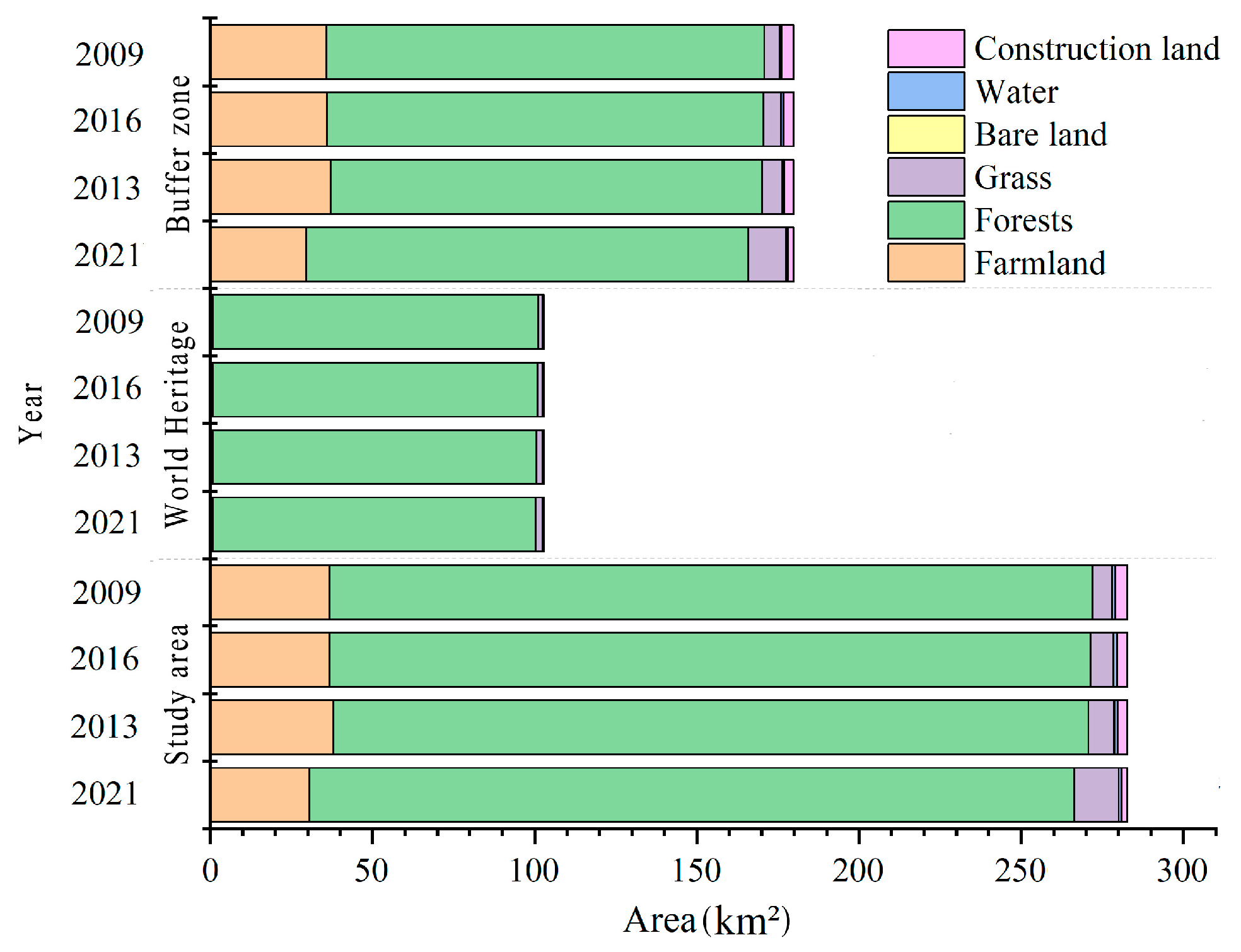

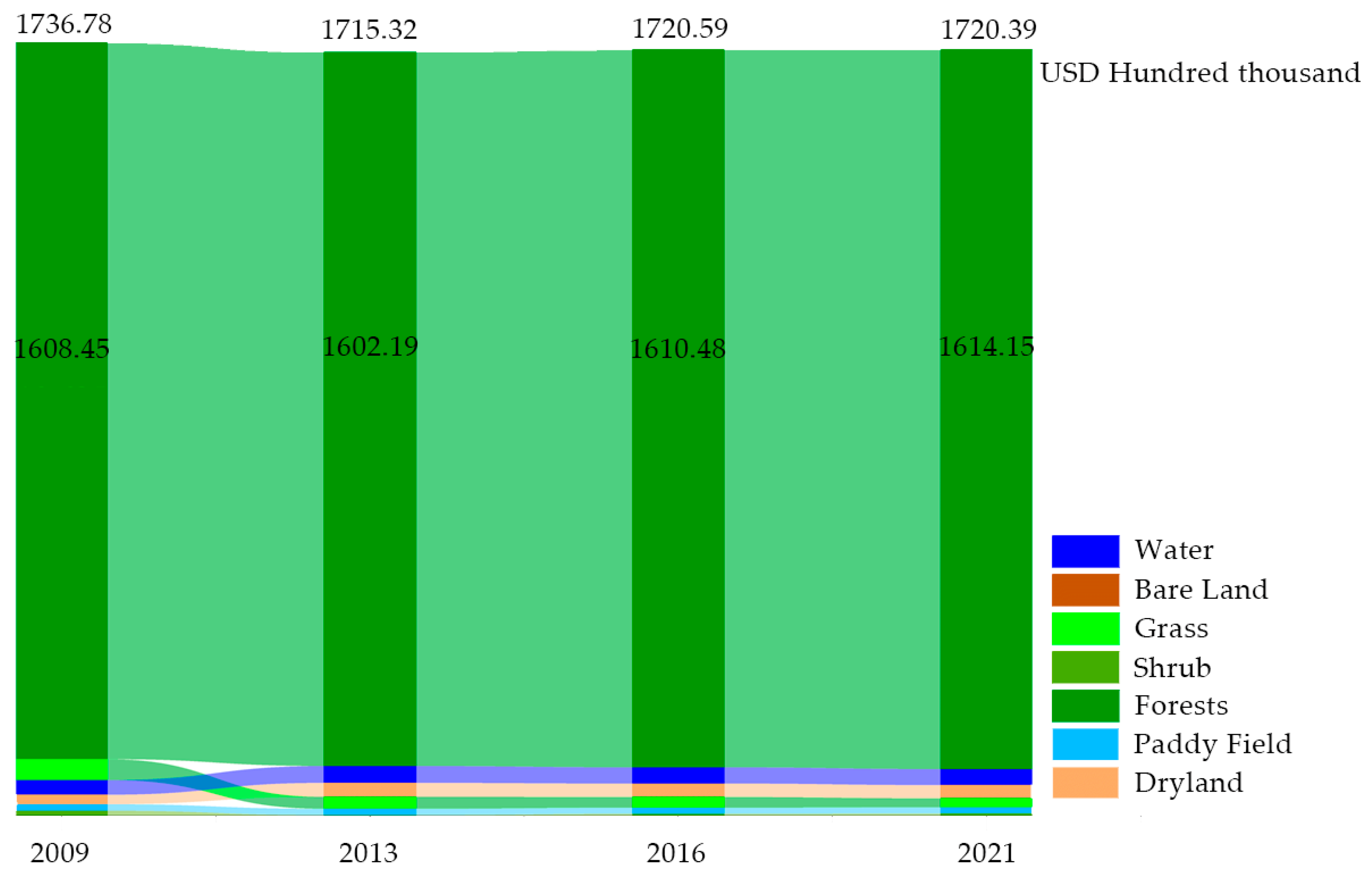
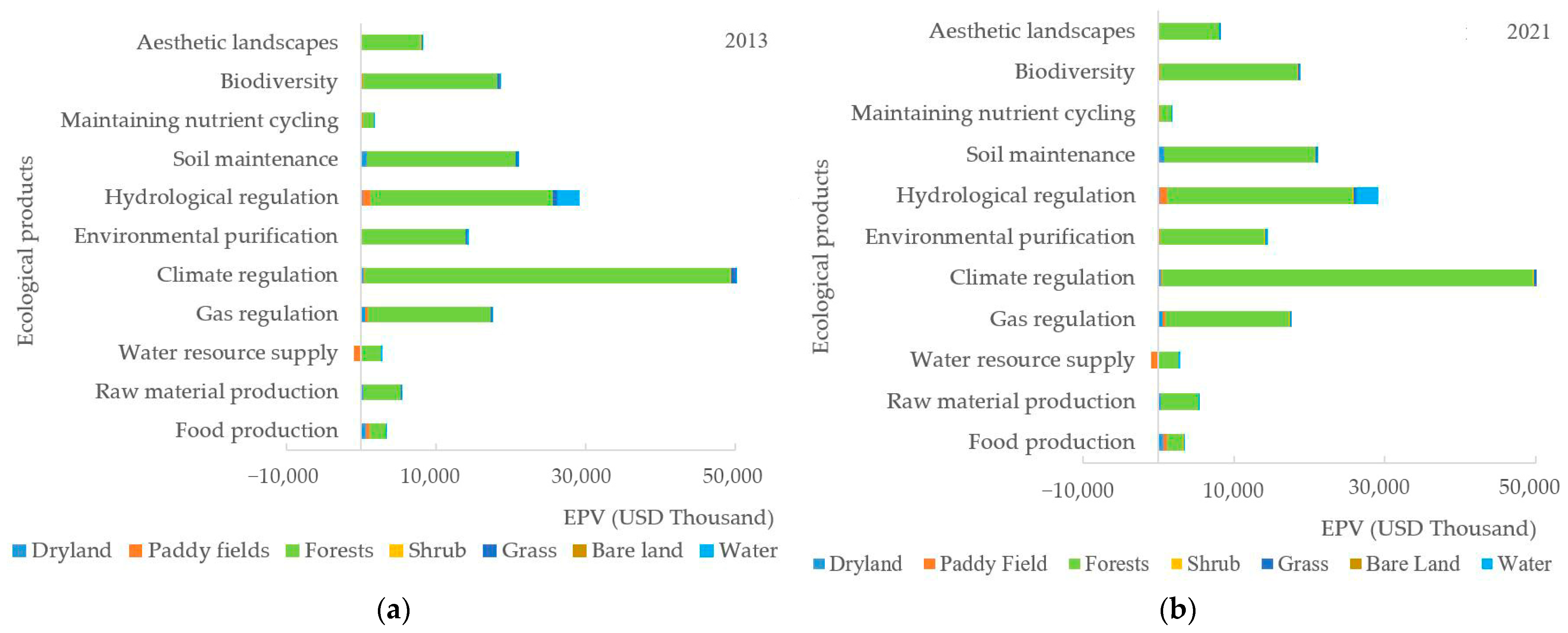

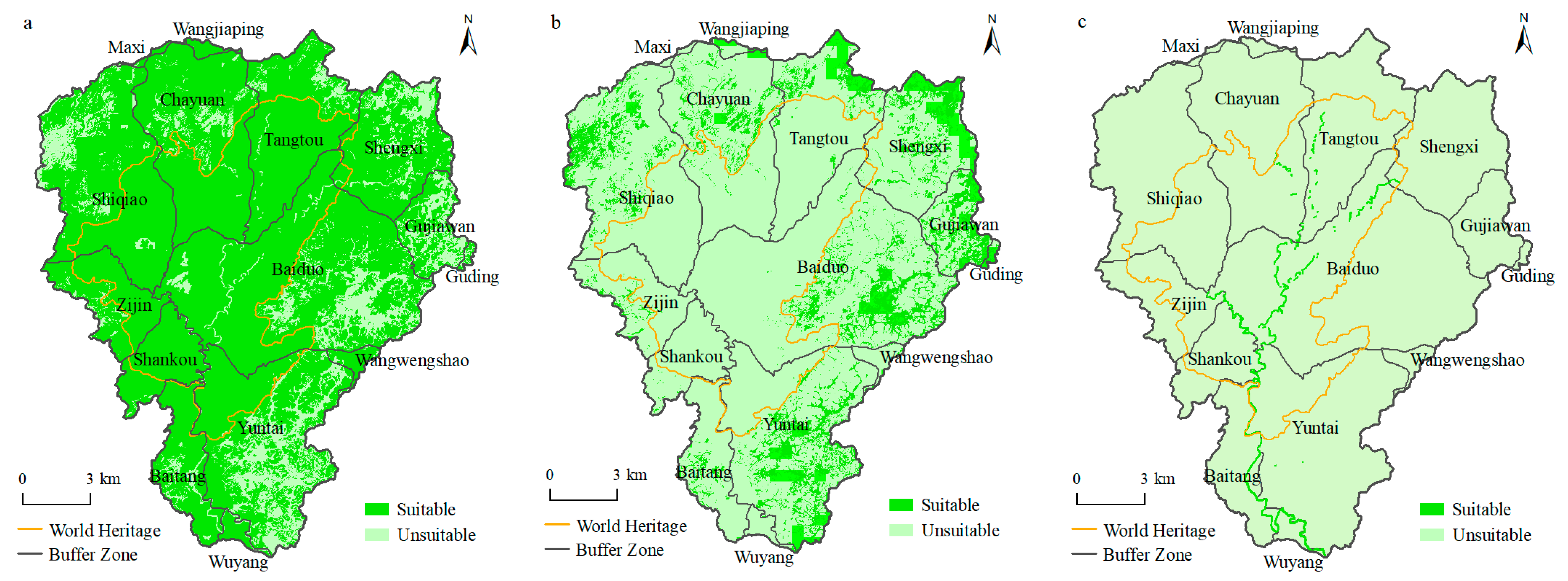
| Crop Types | Planting Area (ha) | Yield (kg/ha) | Price (USD kg−1) |
|---|---|---|---|
| Grains | 6520.34 | 5897.70 | 0.54 |
| Beans | 734.33 | 1266.45 | 1.12 |
| Potatoes | 5166.74 | 4148.07 | 0.19 |
| Service Types | Ecological Products | Dryland | Paddy Field | Forests | Shrub | Grass | Bare Land | Water |
|---|---|---|---|---|---|---|---|---|
| Supply Services (A) | Food Production (A1) | 254.11 | 406.57 | 92.67 | 56.80 | 65.77 | 0.00 | 239.16 |
| Raw Material Production (A2) | 119.58 | 26.91 | 212.25 | 128.55 | 128.55 | 0.00 | 68.76 | |
| Water Supply (A3) | 5.98 | −786.24 | 110.61 | 65.77 | 53.81 | 0.00 | 2478.30 | |
| Regulation Services (B) | Gas Regulation (B1) | 200.30 | 331.83 | 702.53 | 421.52 | 340.80 | 5.98 | 230.19 |
| Climate Regulation (B2) | 107.62 | 170.40 | 2101.62 | 1264.56 | 902.83 | 0.00 | 684.60 | |
| Purifying Environment (B3) | 29.90 | 50.82 | 594.91 | 382.66 | 298.95 | 29.90 | 1659.17 | |
| Hydrological Regulation (B4) | 80.72 | 813.14 | 1049.31 | 1001.48 | 660.68 | 8.97 | 30,564.65 | |
| Support Services (C) | Soil Conservation (C1) | 307.92 | 2.99 | 855.00 | 514.19 | 415.54 | 5.98 | 278.02 |
| Maintain Nutrient Cycling (C2) | 35.87 | 56.80 | 65.77 | 38.86 | 32.88 | 0.00 | 20.93 | |
| Biodiversity (C3) | 38.86 | 62.78 | 777.27 | 469.35 | 379.67 | 5.98 | 762.32 | |
| Cultural services (D) | Aesthetic Landscape (D1) | 17.94 | 26.91 | 340.80 | 206.28 | 167.41 | 2.99 | 565.02 |
| Land Types | 1000 m | 500 m | 250 m |
|---|---|---|---|
| Farmland |  | 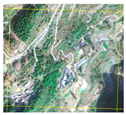 | 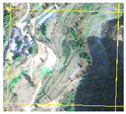 |
| Grass | 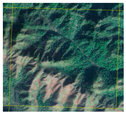 | 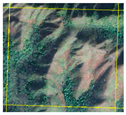 | 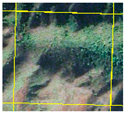 |
| Forests | 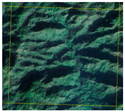 | 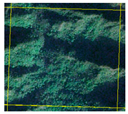 | 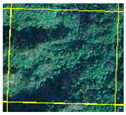 |
| Water | 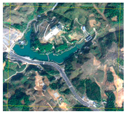 |  |  |
| Construction land | 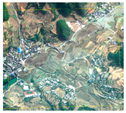 | 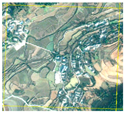 |  |
| Dominant Models | Spatial Zoning Indicators | Contribution Values of Land Types (USD Thousand) | Values of Forest Ecosystem (USD Thousand) | Values of Farmland Ecosystem (USD Thousand) | Values of Wetland Ecosystem (USD Thousand) | |
|---|---|---|---|---|---|---|
| Ecological Forestry Economy | B2, B3, C1, C3, B1, B3, D1 | Values From high to low ↓ | Forests (161,415.65) | B2 (49,144.74) | B4 (1169.70) | B4 (2915.89) |
| Water (3582.40) | B4 (24,537.42) | A1 (1114.10) | A3 (236.43) | |||
| Dryland (2968.24) | C1 (19,993.45) | B1 (891.72) | B3 (158.29) | |||
| Grassland (2029.83) | C3 (18,175.86) | C1 (765.98) | C3 (72.73) | |||
| Characteristic Agricultural Economy | B4, A1, B1, C1, B2, A2 | Paddy Field (1387.02) | B1 (16,428.18) | B2 (469.72) | B2 (65.31) | |
| Shrub (655.53) | B3 (13,911.53) | A2 (328.17) | D1 (53.90) | |||
| Bare Land (0.56) | D1 (7969.42) | C3 (171.11) | C1 (26.52) | |||
| A2 (4963.41) | C2 (156.57) | A1 (22.82) | ||||
| Ecological Water Economy | B4, A3, B3, C3, B2, D1, C1 | A1 (2167.12) | B3 (134.64) | B1 (21.96) | ||
| A3 (2586.57) | D1 (76.50) | A2 (6.56) | ||||
| C2 (1537.96) | A3 (−922.95) | C2 (2.00) |
| Dominant Models | Spatial Distribution in Villages | The Property/ Buffer Zone | Characteristics and Realization Paths |
|---|---|---|---|
| Ecological Forestry Economy | The west, north, and northeast of Baiduo Village; the west of Yuntai; the east of Shiqiao; the south and north of Chayuan; and the south of Tangtou | Mainly in the property, followed by buffer zone | Products trading of planting and breeding under forests, forest land circulation and forest rights trading, forest carbon sink trading, leisure tourism, and so on. |
| Characteristic Agricultural Economy | The south of Yuntai Village; the east of Baiduo; the east and center of Gujiawan; the north of Shengxi and Tangtou; the center of Chayuan; and the west of Shiqiao and Zijing | Buffer zone | The characteristics of mountainous cultivated land are obvious and widely distributed, making it suitable for mountainous high-quality agriculture, farmhouse entertainment, leisure agriculture, and so on |
| Ecological Water Economy | Wuyang Village; Baitang; Shankou; Baiduo; and Tangtou | The property and buffer zone | Basin ecological compensation, water bank, river tourism development, and so on |
Disclaimer/Publisher’s Note: The statements, opinions and data contained in all publications are solely those of the individual author(s) and contributor(s) and not of MDPI and/or the editor(s). MDPI and/or the editor(s) disclaim responsibility for any injury to people or property resulting from any ideas, methods, instructions or products referred to in the content. |
© 2023 by the authors. Licensee MDPI, Basel, Switzerland. This article is an open access article distributed under the terms and conditions of the Creative Commons Attribution (CC BY) license (https://creativecommons.org/licenses/by/4.0/).
Share and Cite
Zhang, Z.; Xiong, K.; Huang, D.; Zhang, W.; Chang, H. Spatial Zoning of the Value Realization Models for Ecological Products in Shibing Karst Natural World Heritage Site. Forests 2023, 14, 1449. https://doi.org/10.3390/f14071449
Zhang Z, Xiong K, Huang D, Zhang W, Chang H. Spatial Zoning of the Value Realization Models for Ecological Products in Shibing Karst Natural World Heritage Site. Forests. 2023; 14(7):1449. https://doi.org/10.3390/f14071449
Chicago/Turabian StyleZhang, Zhenzhen, Kangning Xiong, Denghong Huang, Wenxiu Zhang, and Huanhuan Chang. 2023. "Spatial Zoning of the Value Realization Models for Ecological Products in Shibing Karst Natural World Heritage Site" Forests 14, no. 7: 1449. https://doi.org/10.3390/f14071449
APA StyleZhang, Z., Xiong, K., Huang, D., Zhang, W., & Chang, H. (2023). Spatial Zoning of the Value Realization Models for Ecological Products in Shibing Karst Natural World Heritage Site. Forests, 14(7), 1449. https://doi.org/10.3390/f14071449






